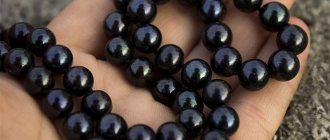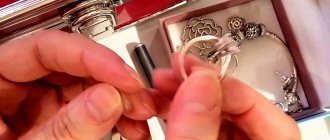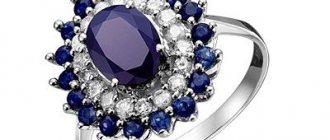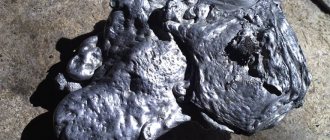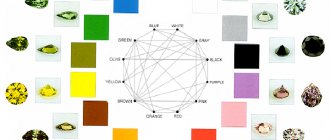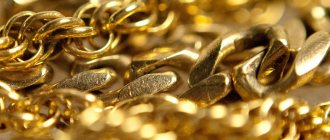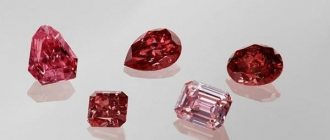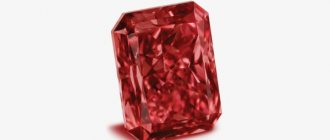All jewelry connoisseurs, when talking about corundum, are primarily interested in whether it is a precious stone or not. Its two varieties are precious - ruby and sapphire. In fact, without specifying the variety, corundum refers to stones with a quality lower than jewelry, which are often refined, as well as synthetic inserts. For the latter, the tag may indicate either “corundum” or “synthetic”. ruby"/"synth. sapphire".
History of the stone
The term “corundum” - comes from the ancient Hindu word korund, the meaning of which is unknown - began to be called the stone that was first brought to Europe from India. Its precious varieties have been known since ancient times. Even the ancient Tamils, a people in South Asia, found hard, opaque stones of a grayish color, and they called them “corundam”.
Archaeological finds indicate that 2000 years ago rubies were already valued in India and were used as talismans. There is a version that red corundums have been mined in Burma since at least the 6th century BC. e.
In medieval Rus', rubies and sapphires were called yakhonts, scarlet and azure yakhonts, respectively. The fact that sapphire and ruby are related was only established by Europeans in 1800. And a hundred years later they learned to synthesize them.
Physical and chemical properties of corundum
Corundum in its formula is aluminum oxide (alumina). Various impurities give the mineral a particular shade, which allows it to be classified as a specific variety.
Corundum is a very hard mineral. The hardness of both ruby and sapphire is 9 on the Mohs scale, surpassed only by a 10-point diamond. At the same time, the minerals of the group are fragile.
Corundums can be either transparent or translucent or completely opaque. Only the first ones claim to be of the highest quality and are suitable for jewelry purposes.
Zodiac compatibility
According to the zodiac, this is the optimal stone for Sagittarius, favorably emphasizing the lightness and sincerity of their character. It will suit silent and pathologically honest Pisces.
Necklace with natural pink sapphire
But for a zodiac sign like Gemini, it’s better to beware of pink sapphire.
| Zodiac sign | Compatibility |
| Aries | + |
| Taurus | + |
| Capricorn | + |
| Cancer | + |
| a lion | + |
| Virgo | + |
| Scales | + |
| Scorpion | + |
| Sagittarius | +++ |
| Capricorn | _ |
| Aquarius | +++ |
| Fish | + |
(“+++” – fits perfectly, “+” – can be worn, “-” – is strictly contraindicated)
Varieties and colors
Red varieties of corundum are called rubies, all others (colorless, blue, violet, green, yellow, orange, pink) are called sapphires.
In general, the following varieties are distinguished for corundum as a mineral species:
· Ruby is a red stone of various shades; rubies of the “pigeon’s blood” color are especially in demand.
· Sapphires - come in blue, cornflower blue and colored (yellow, orange, pink, green, purple).
Leucosapphire is a colorless sapphire.
· Padparadscha is a pinkish-orange sapphire, although its color has a more poetic definition: the color of “a lotus flower in the rays of the setting sun in Sri Lanka.”
· Star ruby and star sapphire are gemstones with the effect of asterism, which is manifested by observing the shape of a six- or twelve-pointed star when light hits a cabochon-shaped surface.
· Ordinary corundum is an opaque coarse- or fine-grained stone of a grayish color.
· Emery is a granular corundum rock of gray-black color.
· Synthetic (artificial) corundum - lilac-pink varieties are called “French rose” or “rose of France”.
The red color of ruby is due to an admixture of chromium, and the blue of sapphire is due to an admixture of titanium and iron. The yellow color is due to the presence of ferric iron.
Place of Birth
The largest deposit of sapphires, including pink ones, is located on the island-state of Sri Lanka (formerly controlled by the British crown of Ceylon). Other large padparadscha mining sites are concentrated in the western part of Hindustan.
Pink sapphire bracelet
Some pink corundum comes from Madagascar, Tanzania and Zimbabwe, but you should be aware that some of the padparadscha coming from South Africa is not naturally as such. These are ordinary greenish or yellow sapphires that are subjected to high temperature annealing, as a result of which they change color to pale lilac and the like. Whether they should be considered fake is a controversial issue, since from a chemical and gemological point of view these are true sapphires.
Application of corundum
Precious sapphire and ruby are widely used in jewelry, but the use of corundum is not limited to this area. Thus, large crystals are collectible exhibits. A mixture of corundum and magnetite (emery) and artificial corundum are used as an abrasive material. Synthetic corundum was once used to make acoustic styli for record players.
High-quality “synthetics” are used to make precision mechanisms, lasers and other optical devices. Vacuum-dense corundum ceramics are used as an insulator with high thermal conductivity in the production of radio tubes and microcircuit packages. Burners for high-pressure sodium lamps are made from artificially produced leucosapphire.
Ordinary corundum, having a high melting point, is used as a refractory material and in the manufacture of enamels.
Artificial corundum
In 1892, the French chemist Auguste Verneuil - although attempts had been made by scientists before him - developed a process for synthesizing corundum crystals from pure aluminum oxide. The first synthetic mineral that began to be artificially grown on an industrial scale and used instead of natural stones for technical purposes and jewelry production was ruby.
The scope of application of ruby and white sapphire has expanded, which required the development of methods for growing them that would make it possible to obtain crystals that were structurally perfect and fairly large. Such methods have been found: abroad they were based on the Czochralski method (growing crystals from a melt), and in Russia on the zone melting method. Methods have also been developed for growing ruby and leucosapphire crystals from solutions in a melt (flux method), from the gas phase and under hydrothermal conditions.
Today, jewelry uses mainly synthesized corundum of red and blue colors, and to a lesser extent stones of other colors. Interestingly, the synthesis of even star rubies and sapphires is possible.
In Soviet gold jewelry, all rubies, unfortunately, are synthetic, so they cannot be sold profitably.
Possible harm from the gem
If you want to buy earrings, bracelets or other jewelry with a similar sapphire, it is important to consider that it has strong energy. If this is not taken into account, then it can cause harm to its owner. For example, when regularly wearing a gem, a person becomes overly irritable, restless, has an increased sense of anxiety, and develops mental disorders.
Crystals with various defects also have negative properties. In some cases, they simply do not bring a positive effect, and at worst, they are dangerous to health. If the stone is tarnished, it attracts enemies, provokes family quarrels, and a cracked gem attracts all sorts of problems and evil forces to the owner.
How to distinguish natural corundum from synthetic corundum
In the photo there is a ring with blue synthetic corundum - you can visually distinguish it from a real sapphire without reading the information on the tag, except by the price. To determine the nature of a stone, experts use a microscope, a refractometer and other instruments, because it is impossible to distinguish a natural stone from an artificially grown one by eye.
Rubies, unlike sapphires, have ultraviolet luminosity. If you shine an ultraviolet flashlight on the sample, both natural ruby and “synthetic” will glow, but the latter is much brighter. Natural red corundum contains multiple inclusions that are visible to the naked eye.
Sapphires
Natural Sapphire stone
Sapphires belong to the corundum family, and therefore are related to minerals that are completely opposite in color - rubies. They are not similar, but are a product of the same breed. Sapphires are known as precious and very hard stones, which in their strength characteristics are second only to diamonds. Like rubies, they are transparent, but in most cases they have a blue tint. Although this is not an absolute axiom.
Natural black star sapphire
Everyone is accustomed to thinking of sapphires as exclusively blue or blue minerals, but in fact they have much more shades in their color range. They are born in yellowish colors, orange, pale blue, green (that is, a mixture of yellow and blue, visually appearing green), and also almost transparent.
The value of sapphires is calculated from many parameters, but primarily from the intensity and brightness of their shade. The deeper and more intense the color, the higher the cost of the future product. But with all this, too dark, almost black sapphires are not very highly valued; they are considered rather a defect.
Sapphires are transparent minerals with a beautiful glassy luster. They may contain impurities, but they are usually not visible to the naked eye. In some cases, impurities can form entire patterns in the stone, for example, star formation, creating the effect of asterism, which is rare and valuable among minerals. At the same time, if a gem has too many impurities, this reduces its value. The golden mean is important in everything, and this also applies to stones.
Since sapphires have amazing strength, they can be processed into different types of shapes. They apply to both simple types of cuts and very complex ones, emerald, for example. Of course, more intricate shapes will cost more, while simpler shapes can be sold at very reasonable prices.
Many stone samples are subjected to processing, such as heating. This improves their transparency and color characteristics. If a sapphire is born too pale, it can be brought to a blue tint by heat treatment. Diffuse treatment and beryllium treatment are also used. The buyer must be notified of all such manipulations before purchasing sapphire.
The therapeutic properties of the mineral include calming, getting rid of nervous diseases and mental disorders. The stone helps with depression. The magic of the stone extends to imparting calm, protecting against negativity, and improving memory. It is believed that the mineral is able to retain information about the previous owner after his death. It is also recommended to wear a stone if its owner wants to become smart; for this purpose, the mineral should be licked in order to cleanse the mind of filth and make room for knowledge.
Sapphire is easy to care for and is not afraid of other stones except diamonds. But it should be kept away from other products so that they are not damaged due to close placement with solid sapphire.
How to care for products
Stones in jewelry will not lose their shine and original appearance longer if you follow simple recommendations:
· Remove rings when performing household chores and washing hands.
· Make sure that the jewelry does not come into contact with creams and perfume - let them absorb before putting on the ring or necklace.
· Use non-abrasive products specifically designed for this purpose when cleaning jewelry.
Cost of jewelry
Large rubies are among the most expensive stones. Large red corundums are extremely rare, so a stone weighing 3 carats or more can be purchased for $30,000 per carat. The price for stones weighing no more than 2 carats ranges from $500 to $2,000 per carat.
Large sapphires are more common, so their cost is lower. Yellow and other varieties of corundum are in low demand, hence their low prices. The cost of a blue star sapphire starts at $150 per carat.
The cost of synthesized corundums is incomparably lower than natural ones.
How much should you pay for precious jewelry?
Before visiting jewelry boutiques, it is important to understand the principles of pricing for jewelry with natural stone. The final cost is determined from the physical properties of the corundum itself and the price of the metal chosen for cutting the product. Of course, a ring with diamonds and sapphire will cost much more than a ring set in silver with a small stone without the use of additional gems.
On average, we can highlight approximate prices for popular jewelry:
- small earrings with artificially grown sapphire in a silver frame cost approximately 800-1000 rubles;
- silver rings with a real stone can cost from 500 rubles and much more;
- a gold ring decorated with 1 small gem costs approximately 10 thousand rubles, if you are offered to pay much less, the buyer is offered a low-quality fake;
- small stud earrings decorated with corundum cost at least 4 thousand rubles.
Magical properties of the stone
Certain magical properties are attributed to precious varieties of corundum. Thus, it is believed that ruby awakens hidden talents, helps to demonstrate leadership qualities and reach a new professional level. It especially helps people who have reached a high position in society, who are accustomed to making their own way. Increases the social status of the owner.
It is not recommended for people with a quick temper to wear a ruby, as the stone can increase their temper several times.
They believe that blue sapphire helps to clear your head of unnecessary thoughts and concentrate on the main thing, accept reality as it is, and make a choice. The stone is indispensable in finding your own purpose. And yellow sapphire helps in creative endeavors.
Neither one nor the other gemstone is recommended to be worn constantly. And for the mineral to have an effect, it must come into direct contact with the skin.
Who is it suitable for?
Mystics claim that yellow corundums received as a gift have the strongest energy. When purchasing on your own, it is important to think only good thoughts, you need to forget about negativity, anger, jealousy and pride. Wearing sapphire together with other minerals is not recommended. The maximum energy potential is achieved when it coincides with the energy of the carrier. He will be an ideal companion for purposeful, strong representatives of the zodiac circle, with the exception of Capricorns - he takes away their vitality, strengthening their negative qualities.
The gem acts differently on each representative of the zodiac circle:
- The stone helps men of the Sagittarius sign gain confidence and become purposeful, and women of this zodiac family receive cosmic protection from corundum.
- Aries women receive a good amulet from ill-wishers, and men will be able to master their hot-tempered temperament.
- Thanks to the gem, Virgos become confident in their abilities and learn to establish relationships with others.
- The mineral will help cancers get rid of health problems, in particular diseases of the genitourinary organs and liver.
- For Gemini, the stone will help control their dual nature and reveal their creative skills.
- For Scorpios, the stone suppresses internal anxiety and controls their impulsive nature.
- Leos gain spiritual balance and tranquility when wearing any jewelry with a solar gem.
- Taurus will learn to compromise and will be able to control their stubborn temper.
- Pisces will forget about the negative, become self-confident, learn to see positive aspects around them and stop paying attention to negative aspects.
- When wearing the stone, Libra will become calmer and learn to make sane decisions, ignoring emotions.
- Aquarians will be able to realize their creative abilities and gain a strong natural attractiveness.
According to astrologers, yellow sapphire is an ideal mineral for Sagittarius and Aquarius. It has the maximum influence on these signs. For the rest, it will help strengthen their positive qualities, with the exception of Capricorns.
